Laparoscopic Trocar and Cannula
The word “trocar” is usually used to refer to the entire assembly but actual trocar is a stylet that is introduced through the cannula. The trocars are available with different types of tips. The cutting tips of these trocars are either in the shape of a three-edged pyramid or a flat two-edged blade. Conical tipped trocars are supposed to be less traumatic to the tissue. The tip can be penetrated through the parietal wall without cutting and a decreased risk of herniation or hemorrhage is reported.
Cannulas are in general made from plastic or metal. Plastic devices whether they are transparent or opaque, need to be designed in such a way as to minimize the reflection of light from the telescope. Reusable and disposable trocars are constructed by a combination of metal and plastic. The tip of the disposable trocar has a two-edged blade. These are very effective at penetrating the abdominal wall by cutting the tissue as they pass through. Most of the disposable plastic trocar has a spring-loaded mechanism that withdraws the sharp tip immediately after it passes through the abdominal wall to reduce the incidence of injury of viscera. Trocar and cannula are of different sizes and diameter depending upon the instrument for which it is used. The diameter of cannula ranges from 3 to 30 mm; the most common size is 5 mm and 10 mm. The metal trocar has a different type of tips, i.e. pyramidal tip, eccentric tip, conical tip, or blunt tip depending on the surgeon’s experience. All the cannula have a valve mechanism at the top.
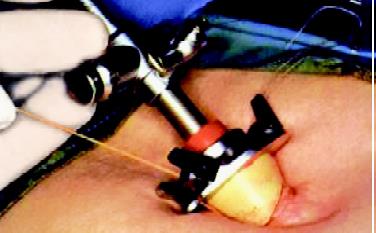 Hasson’s Cannula in the proper position
Hasson’s Cannula in the proper position
Valves of cannula provide internal air seals, which allow instruments to move in and out within a cannula without the loss of pneumoperitoneum. These valves can be oblique, transverse, or in piston configuration.
These valves can be manually or automatically retractable during instrument passage. Trumpet type valves are also present which provide excellent seals, but they are not as practical as some of the other systems. They require both hands during instrument insertion, which may explain why they are less often used in advanced laparoscopic cases. The flexible valves limit the leakage of carbon dioxide during work whatever the diameter of the instrument used.
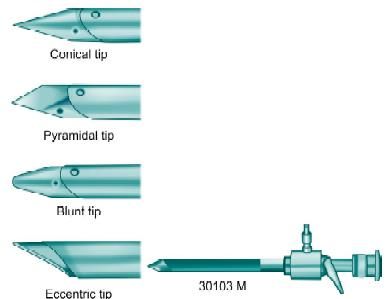
Tip of the trocar
It should be remembered that sharp trocars although looking dangerous are actually better than blunt one because they need less force to introduce inside the abdominal cavity and chances of inadvertent forceful entry of full length of the trocar is less. There is always a difference in the marked exterior diameter of the cannula and the interior usable diameter. The end of the cannula is either straight or oblique. An oblique tip is felt to facilitate the easy passage of the trocar through the abdominal wall. Trocar and cannula should be held in a proper way in hand so that head of the trocar should rest on the thenar eminence, the middle finger should rest over the gas inlet and the index finger is pointed towards the sharp end of the trocar.
Visiport
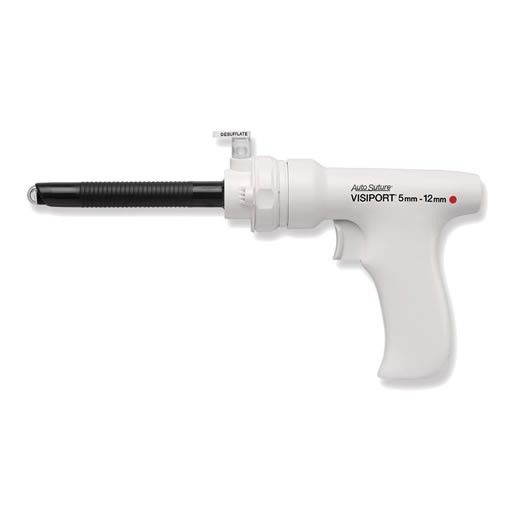
Visiport
The Visiport is a kind of optical trocars which is a disposable and expendable visual entry tool that includes a cannula and hollow trocar with a cutting blade at the tip. It is applied after the insufflation of CO2 in the abdomen. This technique of inserting Visiport is palmed via the surgeon’s hand and maintained perpendicular to distend the patient’s CO2 to the abdomen. When the accurate anatomical status of the trocar tip is checked by visualization of layers of the abdominal wall on the monitor, downward axial pressure is used and activated to trigger cutting blade. Downward pressure causes trocar to advance optical bladed tip and its situation is checked again and again seeing on the monitor. These sequences are repeated until the peritoneal cavity has arrived. This is not fired till the accurate anatomical status of the trocar tip is known. However, none of the laparoscopic entry methods have distinct superiority over others. On the other words, the Visiport technique is also associated with abundant complications. Visiport optical trocar technique is faster for initial trocar placement than the Hasson technique. However, it is associated with complications compared to open Hasson technique. Therefore, there is the benefit with respect to speed for initial trocar placement and harm based on complications of the sharp cutting blade in the Visiport trocar system.
Bladeless Optical Trocar

Bladeless Optical Trocar
There are many single-use Bladeless Optical Trocar System available which provides a versatile, operationally flexible, and unique mode of entry into the abdominal cavity for any laparoscopic procedure. The distinctively engineered visual tip greatly reduces wound defect size as well as insertion force into the abdominal cavity. Injuries due to blind entry and a sharp blade are virtually eliminated with the use of a bladeless optical tip trocar system. The optical tip provides direct visualization of the various tissue layers when accompanied by a laparoscope during insertion. Because the bladeless tip separates and dissects without cutting, trauma to the abdominal wall and vessels are minimized.
Step Trocar
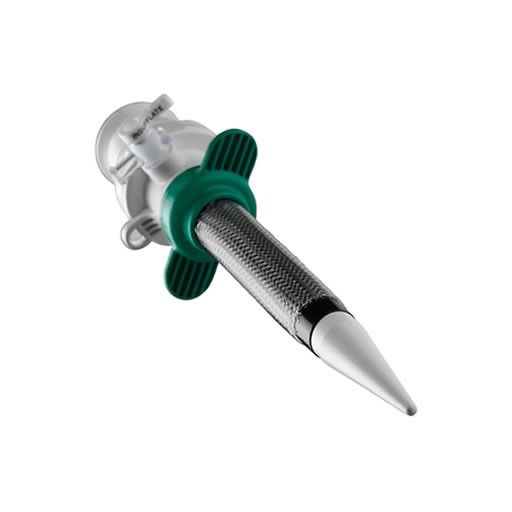
Step radially expanding trocar
Step radially expanding technology allows the Versa Step bladeless trocars to yield smaller fascial defects for an equivalent cannula size compared to conventional bladed trocars. The Versa Step bladeless trocars use Step Radial Dilation technology. The VersaStep system can be found in a 70, 110, or 150mm working length and can be 5, 11, 12, or 15mm in diameter. The trocars are designed to keep fascial issues from being a threat. It can keep gas completely airtight within the abdominal cavity and can help allow instruments from 4.5, 12 or 15mm to be exchanged as needed. In this technology initially, less diameter trocar is introduced which is stretchable. Over this stretchable cannula again desired diameter of the trocar is pushed to radially dilate the abdominal port wound. This results in less chance of hernia. This trocar system is strictly disposable and cannot be used a second time as outer sheath breaks after single-use.
Laparoscopic hand instruments vary in diameter from 1.8 to 12 mm but the majority of instruments are designed to pass through 5 to 10 mm of the cannula. The hand instrument used in laparoscopic surgery are of different lengths (varies company to company and length of the laparoscopic instrument varies from 18–45 cm) but they are ergonomically convenient to work if they have the same length of approximately 36 cm in adult and 28 cm in pediatric practice. Shorter instruments 18 to 25 cm are adapted for cervical and pediatric surgery. Certain procedures for an adult can also be performed with shorter instruments where space is constricted. 45 cm instruments are used in obese or very tall patients. For better ergonomics, half of the instruments should be inside the abdomen and half outside. If half of the instrument is in and half out, it behaves like class 1 lever and it stabilizes the port nicely so the surgery will be convenient.
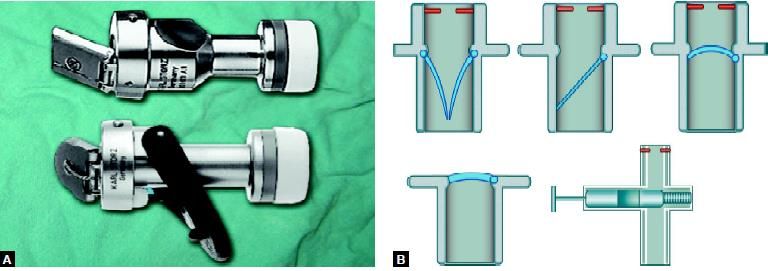
(A) The different valve mechanism of the cannula. (B) The different valve mechanism of cannula (internal view).
The word “trocar” is usually used to refer to the entire assembly but actual trocar is a stylet that is introduced through the cannula. The trocars are available with different types of tips. The cutting tips of these trocars are either in the shape of a three-edged pyramid or a flat two-edged blade. Conical tipped trocars are supposed to be less traumatic to the tissue. The tip can be penetrated through the parietal wall without cutting and a decreased risk of herniation or hemorrhage is reported.
Cannulas are in general made from plastic or metal. Plastic devices whether they are transparent or opaque, need to be designed in such a way as to minimize the reflection of light from the telescope. Reusable and disposable trocars are constructed by a combination of metal and plastic. The tip of the disposable trocar has a two-edged blade. These are very effective at penetrating the abdominal wall by cutting the tissue as they pass through. Most of the disposable plastic trocar has a spring-loaded mechanism that withdraws the sharp tip immediately after it passes through the abdominal wall to reduce the incidence of injury of viscera. Trocar and cannula are of different sizes and diameter depending upon the instrument for which it is used. The diameter of cannula ranges from 3 to 30 mm; the most common size is 5 mm and 10 mm. The metal trocar has a different type of tips, i.e. pyramidal tip, eccentric tip, conical tip, or blunt tip depending on the surgeon’s experience. All the cannula have a valve mechanism at the top.
 Hasson’s Cannula in the proper position
Hasson’s Cannula in the proper positionValves of cannula provide internal air seals, which allow instruments to move in and out within a cannula without the loss of pneumoperitoneum. These valves can be oblique, transverse, or in piston configuration.
These valves can be manually or automatically retractable during instrument passage. Trumpet type valves are also present which provide excellent seals, but they are not as practical as some of the other systems. They require both hands during instrument insertion, which may explain why they are less often used in advanced laparoscopic cases. The flexible valves limit the leakage of carbon dioxide during work whatever the diameter of the instrument used.

Tip of the trocar
It should be remembered that sharp trocars although looking dangerous are actually better than blunt one because they need less force to introduce inside the abdominal cavity and chances of inadvertent forceful entry of full length of the trocar is less. There is always a difference in the marked exterior diameter of the cannula and the interior usable diameter. The end of the cannula is either straight or oblique. An oblique tip is felt to facilitate the easy passage of the trocar through the abdominal wall. Trocar and cannula should be held in a proper way in hand so that head of the trocar should rest on the thenar eminence, the middle finger should rest over the gas inlet and the index finger is pointed towards the sharp end of the trocar.
Visiport

Visiport
The Visiport is a kind of optical trocars which is a disposable and expendable visual entry tool that includes a cannula and hollow trocar with a cutting blade at the tip. It is applied after the insufflation of CO2 in the abdomen. This technique of inserting Visiport is palmed via the surgeon’s hand and maintained perpendicular to distend the patient’s CO2 to the abdomen. When the accurate anatomical status of the trocar tip is checked by visualization of layers of the abdominal wall on the monitor, downward axial pressure is used and activated to trigger cutting blade. Downward pressure causes trocar to advance optical bladed tip and its situation is checked again and again seeing on the monitor. These sequences are repeated until the peritoneal cavity has arrived. This is not fired till the accurate anatomical status of the trocar tip is known. However, none of the laparoscopic entry methods have distinct superiority over others. On the other words, the Visiport technique is also associated with abundant complications. Visiport optical trocar technique is faster for initial trocar placement than the Hasson technique. However, it is associated with complications compared to open Hasson technique. Therefore, there is the benefit with respect to speed for initial trocar placement and harm based on complications of the sharp cutting blade in the Visiport trocar system.
Bladeless Optical Trocar

Bladeless Optical Trocar
There are many single-use Bladeless Optical Trocar System available which provides a versatile, operationally flexible, and unique mode of entry into the abdominal cavity for any laparoscopic procedure. The distinctively engineered visual tip greatly reduces wound defect size as well as insertion force into the abdominal cavity. Injuries due to blind entry and a sharp blade are virtually eliminated with the use of a bladeless optical tip trocar system. The optical tip provides direct visualization of the various tissue layers when accompanied by a laparoscope during insertion. Because the bladeless tip separates and dissects without cutting, trauma to the abdominal wall and vessels are minimized.
Step Trocar

Step radially expanding trocar
Step radially expanding technology allows the Versa Step bladeless trocars to yield smaller fascial defects for an equivalent cannula size compared to conventional bladed trocars. The Versa Step bladeless trocars use Step Radial Dilation technology. The VersaStep system can be found in a 70, 110, or 150mm working length and can be 5, 11, 12, or 15mm in diameter. The trocars are designed to keep fascial issues from being a threat. It can keep gas completely airtight within the abdominal cavity and can help allow instruments from 4.5, 12 or 15mm to be exchanged as needed. In this technology initially, less diameter trocar is introduced which is stretchable. Over this stretchable cannula again desired diameter of the trocar is pushed to radially dilate the abdominal port wound. This results in less chance of hernia. This trocar system is strictly disposable and cannot be used a second time as outer sheath breaks after single-use.
Laparoscopic hand instruments vary in diameter from 1.8 to 12 mm but the majority of instruments are designed to pass through 5 to 10 mm of the cannula. The hand instrument used in laparoscopic surgery are of different lengths (varies company to company and length of the laparoscopic instrument varies from 18–45 cm) but they are ergonomically convenient to work if they have the same length of approximately 36 cm in adult and 28 cm in pediatric practice. Shorter instruments 18 to 25 cm are adapted for cervical and pediatric surgery. Certain procedures for an adult can also be performed with shorter instruments where space is constricted. 45 cm instruments are used in obese or very tall patients. For better ergonomics, half of the instruments should be inside the abdomen and half outside. If half of the instrument is in and half out, it behaves like class 1 lever and it stabilizes the port nicely so the surgery will be convenient.

(A) The different valve mechanism of the cannula. (B) The different valve mechanism of cannula (internal view).





